Dyslexia Disease: Impact, Barriers, and Intervention Strategies Report
VerifiedAdded on 2023/06/10
|25
|7531
|141
Report
AI Summary
This report delves into the complexities of dyslexia, a common learning disorder affecting children, particularly in the United Kingdom. It begins with an executive summary outlining the report's focus on evaluating barriers to learning faced by dyslexic students and their holistic development. The report comprehensively addresses dyslexia, including its symptoms across different educational stages, potential causes such as heredity and brain anatomy, and diagnostic techniques. It explores potential barriers to learning, encompassing challenges in understanding tasks, identifying key points, and handling information. Furthermore, the report critically analyzes the impact of these challenges on a dyslexic student's overall development and evaluates various intervention strategies aimed at providing effective support. The final section presents a short learning program with strategies designed to remove learning barriers for dyslexic students, offering practical solutions for educators and caregivers.
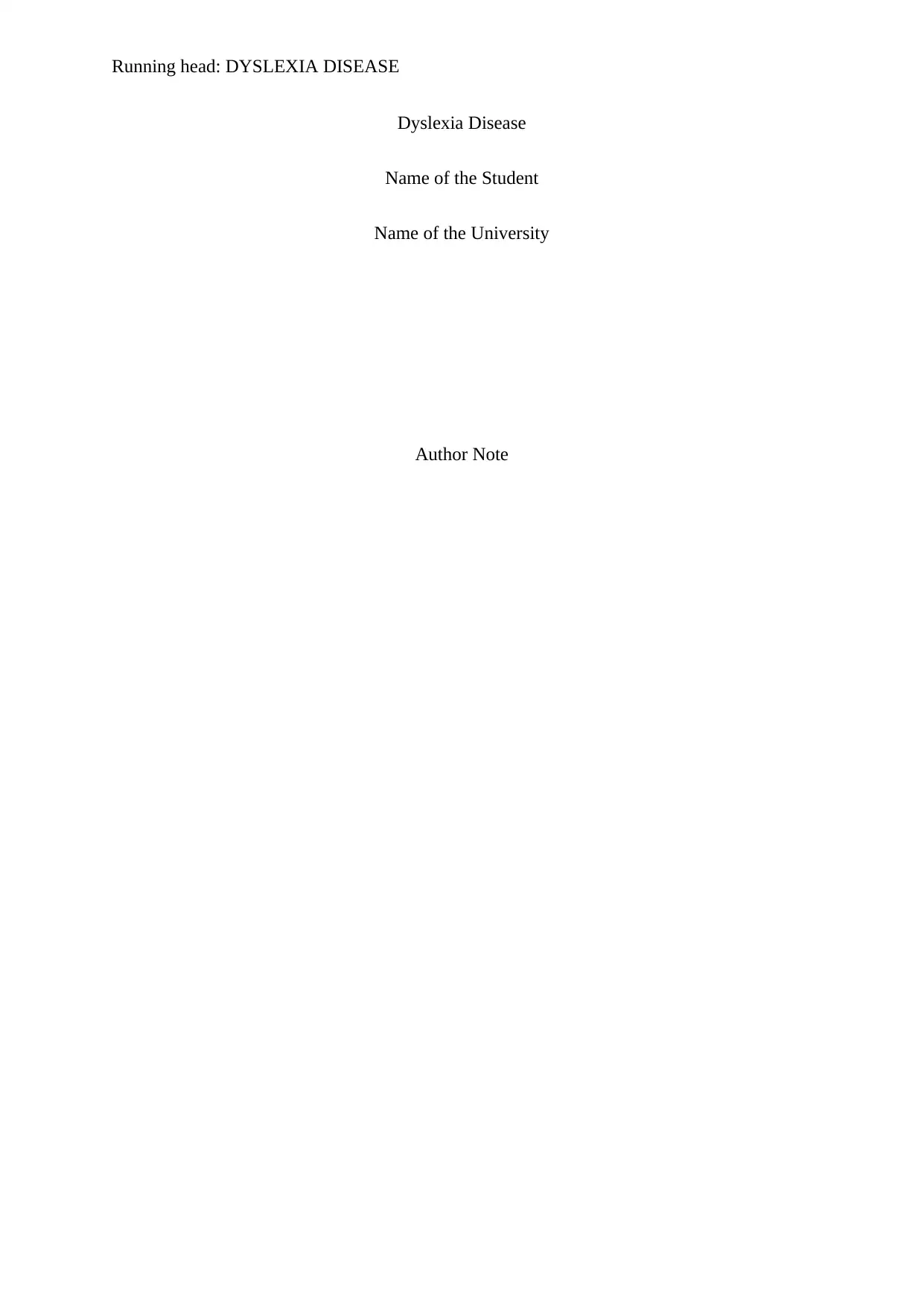
Running head: DYSLEXIA DISEASE
Dyslexia Disease
Name of the Student
Name of the University
Author Note
Dyslexia Disease
Name of the Student
Name of the University
Author Note
Paraphrase This Document
Need a fresh take? Get an instant paraphrase of this document with our AI Paraphraser
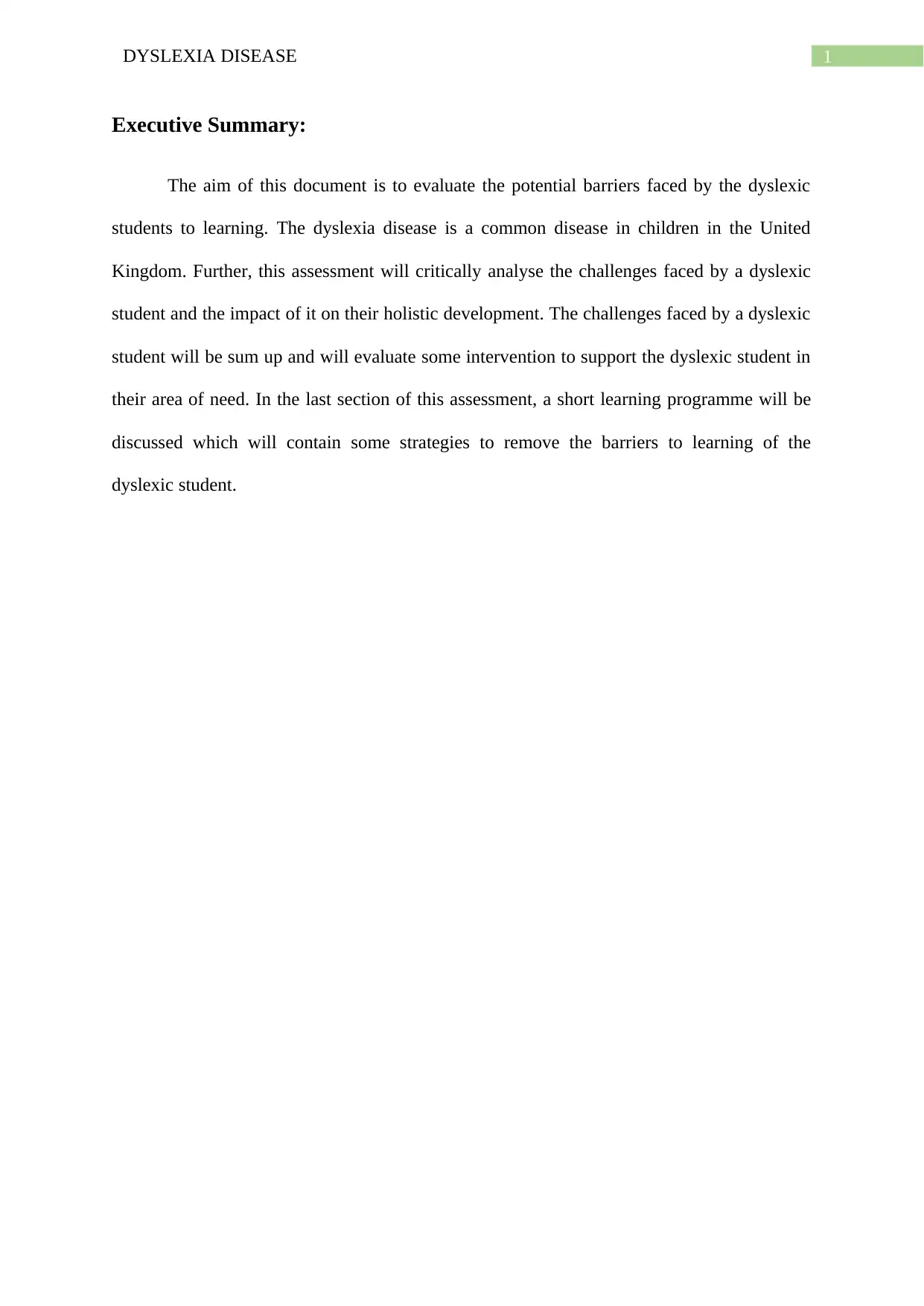
1DYSLEXIA DISEASE
Executive Summary:
The aim of this document is to evaluate the potential barriers faced by the dyslexic
students to learning. The dyslexia disease is a common disease in children in the United
Kingdom. Further, this assessment will critically analyse the challenges faced by a dyslexic
student and the impact of it on their holistic development. The challenges faced by a dyslexic
student will be sum up and will evaluate some intervention to support the dyslexic student in
their area of need. In the last section of this assessment, a short learning programme will be
discussed which will contain some strategies to remove the barriers to learning of the
dyslexic student.
Executive Summary:
The aim of this document is to evaluate the potential barriers faced by the dyslexic
students to learning. The dyslexia disease is a common disease in children in the United
Kingdom. Further, this assessment will critically analyse the challenges faced by a dyslexic
student and the impact of it on their holistic development. The challenges faced by a dyslexic
student will be sum up and will evaluate some intervention to support the dyslexic student in
their area of need. In the last section of this assessment, a short learning programme will be
discussed which will contain some strategies to remove the barriers to learning of the
dyslexic student.
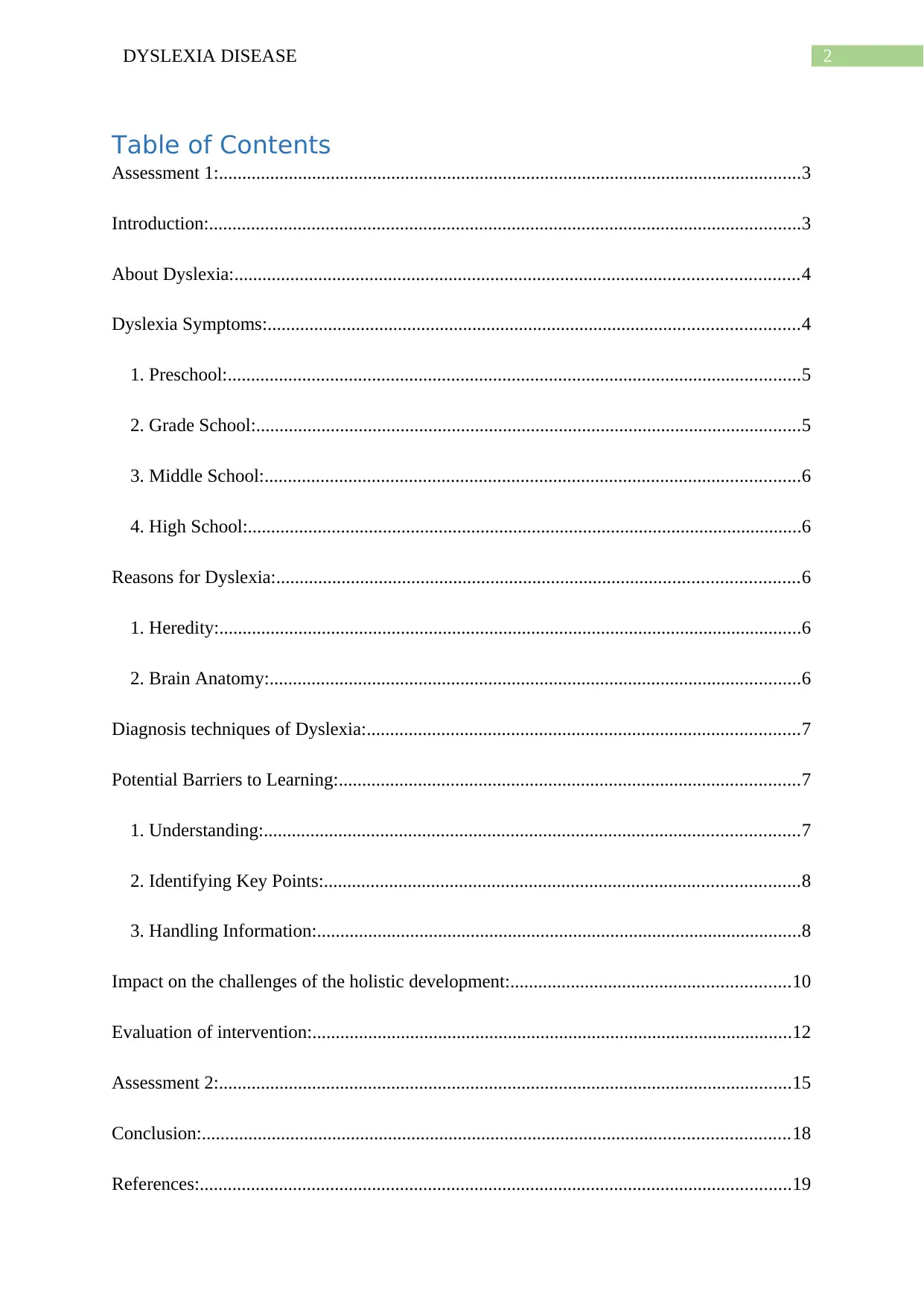
2DYSLEXIA DISEASE
Table of Contents
Assessment 1:.............................................................................................................................3
Introduction:...............................................................................................................................3
About Dyslexia:.........................................................................................................................4
Dyslexia Symptoms:..................................................................................................................4
1. Preschool:...........................................................................................................................5
2. Grade School:.....................................................................................................................5
3. Middle School:...................................................................................................................6
4. High School:.......................................................................................................................6
Reasons for Dyslexia:................................................................................................................6
1. Heredity:.............................................................................................................................6
2. Brain Anatomy:..................................................................................................................6
Diagnosis techniques of Dyslexia:.............................................................................................7
Potential Barriers to Learning:...................................................................................................7
1. Understanding:...................................................................................................................7
2. Identifying Key Points:......................................................................................................8
3. Handling Information:........................................................................................................8
Impact on the challenges of the holistic development:............................................................10
Evaluation of intervention:.......................................................................................................12
Assessment 2:...........................................................................................................................15
Conclusion:..............................................................................................................................18
References:...............................................................................................................................19
Table of Contents
Assessment 1:.............................................................................................................................3
Introduction:...............................................................................................................................3
About Dyslexia:.........................................................................................................................4
Dyslexia Symptoms:..................................................................................................................4
1. Preschool:...........................................................................................................................5
2. Grade School:.....................................................................................................................5
3. Middle School:...................................................................................................................6
4. High School:.......................................................................................................................6
Reasons for Dyslexia:................................................................................................................6
1. Heredity:.............................................................................................................................6
2. Brain Anatomy:..................................................................................................................6
Diagnosis techniques of Dyslexia:.............................................................................................7
Potential Barriers to Learning:...................................................................................................7
1. Understanding:...................................................................................................................7
2. Identifying Key Points:......................................................................................................8
3. Handling Information:........................................................................................................8
Impact on the challenges of the holistic development:............................................................10
Evaluation of intervention:.......................................................................................................12
Assessment 2:...........................................................................................................................15
Conclusion:..............................................................................................................................18
References:...............................................................................................................................19
⊘ This is a preview!⊘
Do you want full access?
Subscribe today to unlock all pages.

Trusted by 1+ million students worldwide
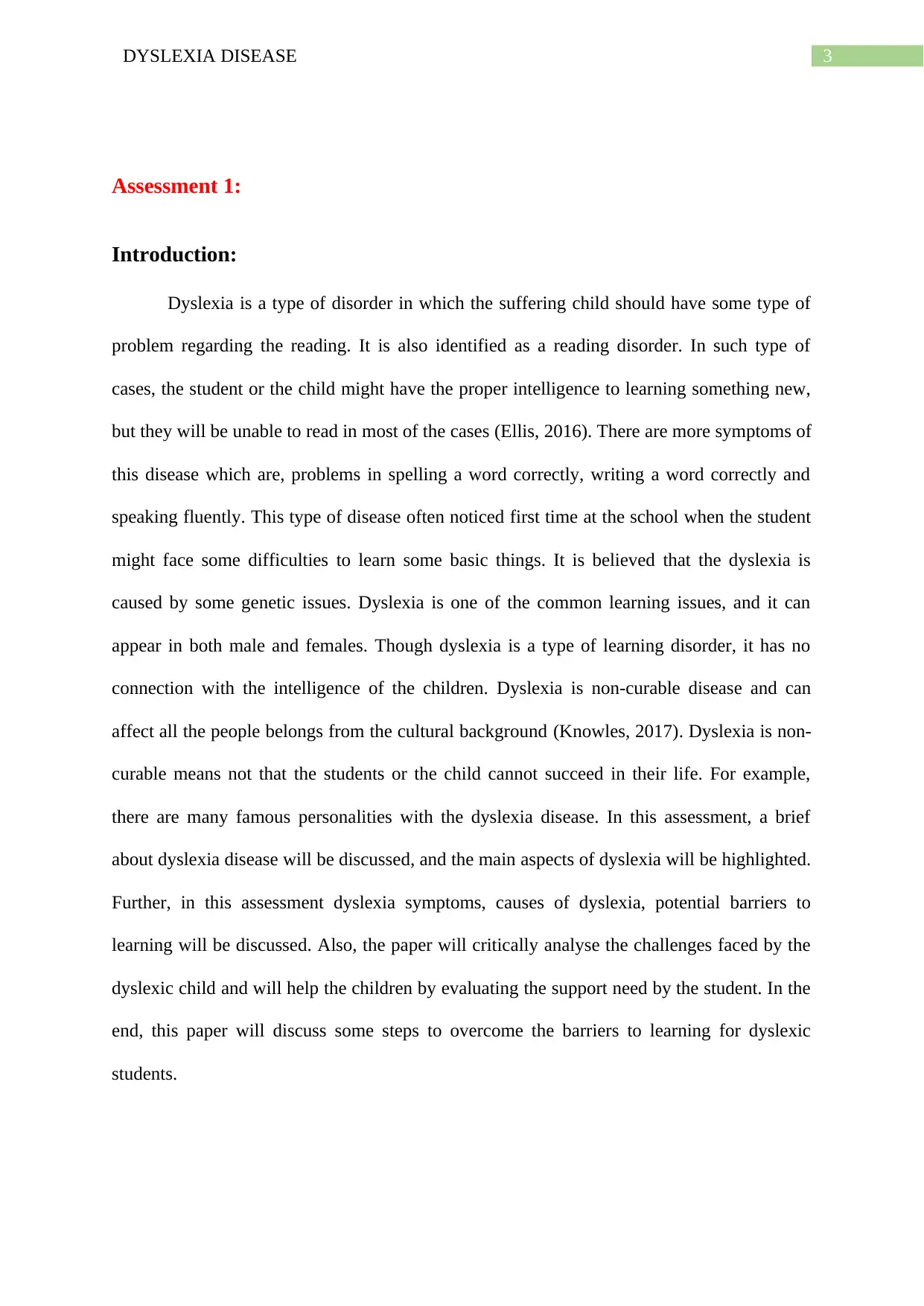
3DYSLEXIA DISEASE
Assessment 1:
Introduction:
Dyslexia is a type of disorder in which the suffering child should have some type of
problem regarding the reading. It is also identified as a reading disorder. In such type of
cases, the student or the child might have the proper intelligence to learning something new,
but they will be unable to read in most of the cases (Ellis, 2016). There are more symptoms of
this disease which are, problems in spelling a word correctly, writing a word correctly and
speaking fluently. This type of disease often noticed first time at the school when the student
might face some difficulties to learn some basic things. It is believed that the dyslexia is
caused by some genetic issues. Dyslexia is one of the common learning issues, and it can
appear in both male and females. Though dyslexia is a type of learning disorder, it has no
connection with the intelligence of the children. Dyslexia is non-curable disease and can
affect all the people belongs from the cultural background (Knowles, 2017). Dyslexia is non-
curable means not that the students or the child cannot succeed in their life. For example,
there are many famous personalities with the dyslexia disease. In this assessment, a brief
about dyslexia disease will be discussed, and the main aspects of dyslexia will be highlighted.
Further, in this assessment dyslexia symptoms, causes of dyslexia, potential barriers to
learning will be discussed. Also, the paper will critically analyse the challenges faced by the
dyslexic child and will help the children by evaluating the support need by the student. In the
end, this paper will discuss some steps to overcome the barriers to learning for dyslexic
students.
Assessment 1:
Introduction:
Dyslexia is a type of disorder in which the suffering child should have some type of
problem regarding the reading. It is also identified as a reading disorder. In such type of
cases, the student or the child might have the proper intelligence to learning something new,
but they will be unable to read in most of the cases (Ellis, 2016). There are more symptoms of
this disease which are, problems in spelling a word correctly, writing a word correctly and
speaking fluently. This type of disease often noticed first time at the school when the student
might face some difficulties to learn some basic things. It is believed that the dyslexia is
caused by some genetic issues. Dyslexia is one of the common learning issues, and it can
appear in both male and females. Though dyslexia is a type of learning disorder, it has no
connection with the intelligence of the children. Dyslexia is non-curable disease and can
affect all the people belongs from the cultural background (Knowles, 2017). Dyslexia is non-
curable means not that the students or the child cannot succeed in their life. For example,
there are many famous personalities with the dyslexia disease. In this assessment, a brief
about dyslexia disease will be discussed, and the main aspects of dyslexia will be highlighted.
Further, in this assessment dyslexia symptoms, causes of dyslexia, potential barriers to
learning will be discussed. Also, the paper will critically analyse the challenges faced by the
dyslexic child and will help the children by evaluating the support need by the student. In the
end, this paper will discuss some steps to overcome the barriers to learning for dyslexic
students.
Paraphrase This Document
Need a fresh take? Get an instant paraphrase of this document with our AI Paraphraser
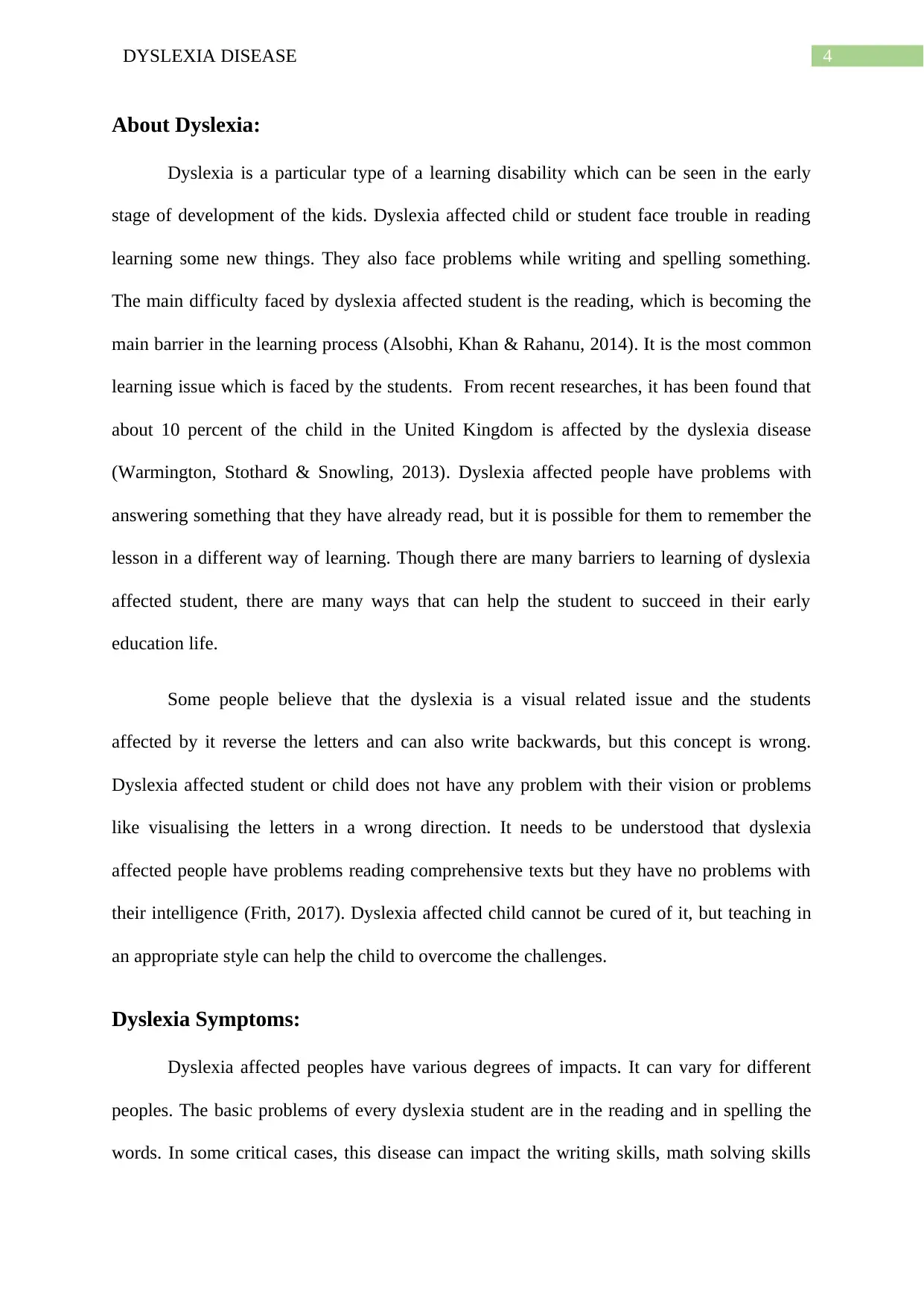
4DYSLEXIA DISEASE
About Dyslexia:
Dyslexia is a particular type of a learning disability which can be seen in the early
stage of development of the kids. Dyslexia affected child or student face trouble in reading
learning some new things. They also face problems while writing and spelling something.
The main difficulty faced by dyslexia affected student is the reading, which is becoming the
main barrier in the learning process (Alsobhi, Khan & Rahanu, 2014). It is the most common
learning issue which is faced by the students. From recent researches, it has been found that
about 10 percent of the child in the United Kingdom is affected by the dyslexia disease
(Warmington, Stothard & Snowling, 2013). Dyslexia affected people have problems with
answering something that they have already read, but it is possible for them to remember the
lesson in a different way of learning. Though there are many barriers to learning of dyslexia
affected student, there are many ways that can help the student to succeed in their early
education life.
Some people believe that the dyslexia is a visual related issue and the students
affected by it reverse the letters and can also write backwards, but this concept is wrong.
Dyslexia affected student or child does not have any problem with their vision or problems
like visualising the letters in a wrong direction. It needs to be understood that dyslexia
affected people have problems reading comprehensive texts but they have no problems with
their intelligence (Frith, 2017). Dyslexia affected child cannot be cured of it, but teaching in
an appropriate style can help the child to overcome the challenges.
Dyslexia Symptoms:
Dyslexia affected peoples have various degrees of impacts. It can vary for different
peoples. The basic problems of every dyslexia student are in the reading and in spelling the
words. In some critical cases, this disease can impact the writing skills, math solving skills
About Dyslexia:
Dyslexia is a particular type of a learning disability which can be seen in the early
stage of development of the kids. Dyslexia affected child or student face trouble in reading
learning some new things. They also face problems while writing and spelling something.
The main difficulty faced by dyslexia affected student is the reading, which is becoming the
main barrier in the learning process (Alsobhi, Khan & Rahanu, 2014). It is the most common
learning issue which is faced by the students. From recent researches, it has been found that
about 10 percent of the child in the United Kingdom is affected by the dyslexia disease
(Warmington, Stothard & Snowling, 2013). Dyslexia affected people have problems with
answering something that they have already read, but it is possible for them to remember the
lesson in a different way of learning. Though there are many barriers to learning of dyslexia
affected student, there are many ways that can help the student to succeed in their early
education life.
Some people believe that the dyslexia is a visual related issue and the students
affected by it reverse the letters and can also write backwards, but this concept is wrong.
Dyslexia affected student or child does not have any problem with their vision or problems
like visualising the letters in a wrong direction. It needs to be understood that dyslexia
affected people have problems reading comprehensive texts but they have no problems with
their intelligence (Frith, 2017). Dyslexia affected child cannot be cured of it, but teaching in
an appropriate style can help the child to overcome the challenges.
Dyslexia Symptoms:
Dyslexia affected peoples have various degrees of impacts. It can vary for different
peoples. The basic problems of every dyslexia student are in the reading and in spelling the
words. In some critical cases, this disease can impact the writing skills, math solving skills
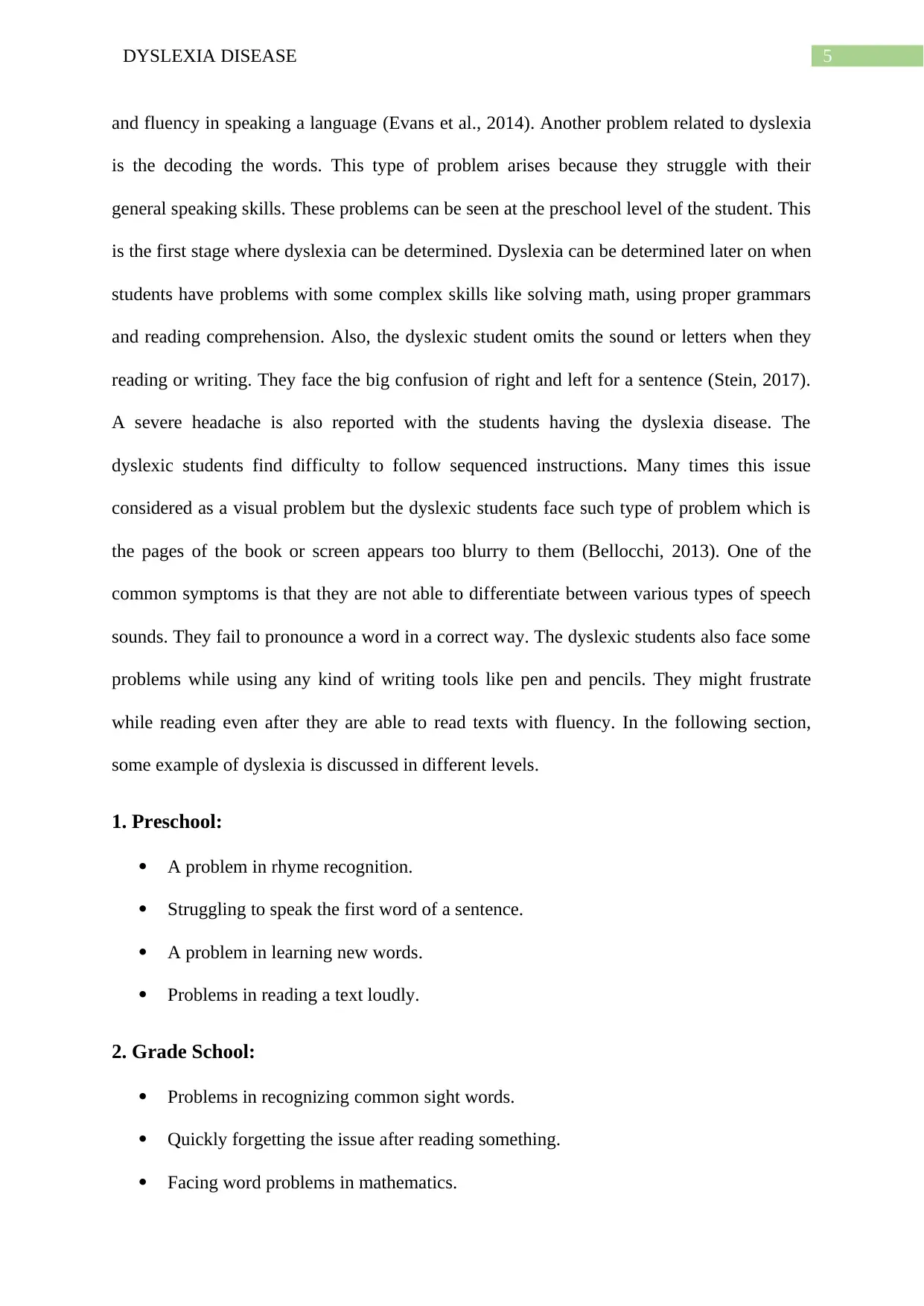
5DYSLEXIA DISEASE
and fluency in speaking a language (Evans et al., 2014). Another problem related to dyslexia
is the decoding the words. This type of problem arises because they struggle with their
general speaking skills. These problems can be seen at the preschool level of the student. This
is the first stage where dyslexia can be determined. Dyslexia can be determined later on when
students have problems with some complex skills like solving math, using proper grammars
and reading comprehension. Also, the dyslexic student omits the sound or letters when they
reading or writing. They face the big confusion of right and left for a sentence (Stein, 2017).
A severe headache is also reported with the students having the dyslexia disease. The
dyslexic students find difficulty to follow sequenced instructions. Many times this issue
considered as a visual problem but the dyslexic students face such type of problem which is
the pages of the book or screen appears too blurry to them (Bellocchi, 2013). One of the
common symptoms is that they are not able to differentiate between various types of speech
sounds. They fail to pronounce a word in a correct way. The dyslexic students also face some
problems while using any kind of writing tools like pen and pencils. They might frustrate
while reading even after they are able to read texts with fluency. In the following section,
some example of dyslexia is discussed in different levels.
1. Preschool:
A problem in rhyme recognition.
Struggling to speak the first word of a sentence.
A problem in learning new words.
Problems in reading a text loudly.
2. Grade School:
Problems in recognizing common sight words.
Quickly forgetting the issue after reading something.
Facing word problems in mathematics.
and fluency in speaking a language (Evans et al., 2014). Another problem related to dyslexia
is the decoding the words. This type of problem arises because they struggle with their
general speaking skills. These problems can be seen at the preschool level of the student. This
is the first stage where dyslexia can be determined. Dyslexia can be determined later on when
students have problems with some complex skills like solving math, using proper grammars
and reading comprehension. Also, the dyslexic student omits the sound or letters when they
reading or writing. They face the big confusion of right and left for a sentence (Stein, 2017).
A severe headache is also reported with the students having the dyslexia disease. The
dyslexic students find difficulty to follow sequenced instructions. Many times this issue
considered as a visual problem but the dyslexic students face such type of problem which is
the pages of the book or screen appears too blurry to them (Bellocchi, 2013). One of the
common symptoms is that they are not able to differentiate between various types of speech
sounds. They fail to pronounce a word in a correct way. The dyslexic students also face some
problems while using any kind of writing tools like pen and pencils. They might frustrate
while reading even after they are able to read texts with fluency. In the following section,
some example of dyslexia is discussed in different levels.
1. Preschool:
A problem in rhyme recognition.
Struggling to speak the first word of a sentence.
A problem in learning new words.
Problems in reading a text loudly.
2. Grade School:
Problems in recognizing common sight words.
Quickly forgetting the issue after reading something.
Facing word problems in mathematics.
⊘ This is a preview!⊘
Do you want full access?
Subscribe today to unlock all pages.

Trusted by 1+ million students worldwide
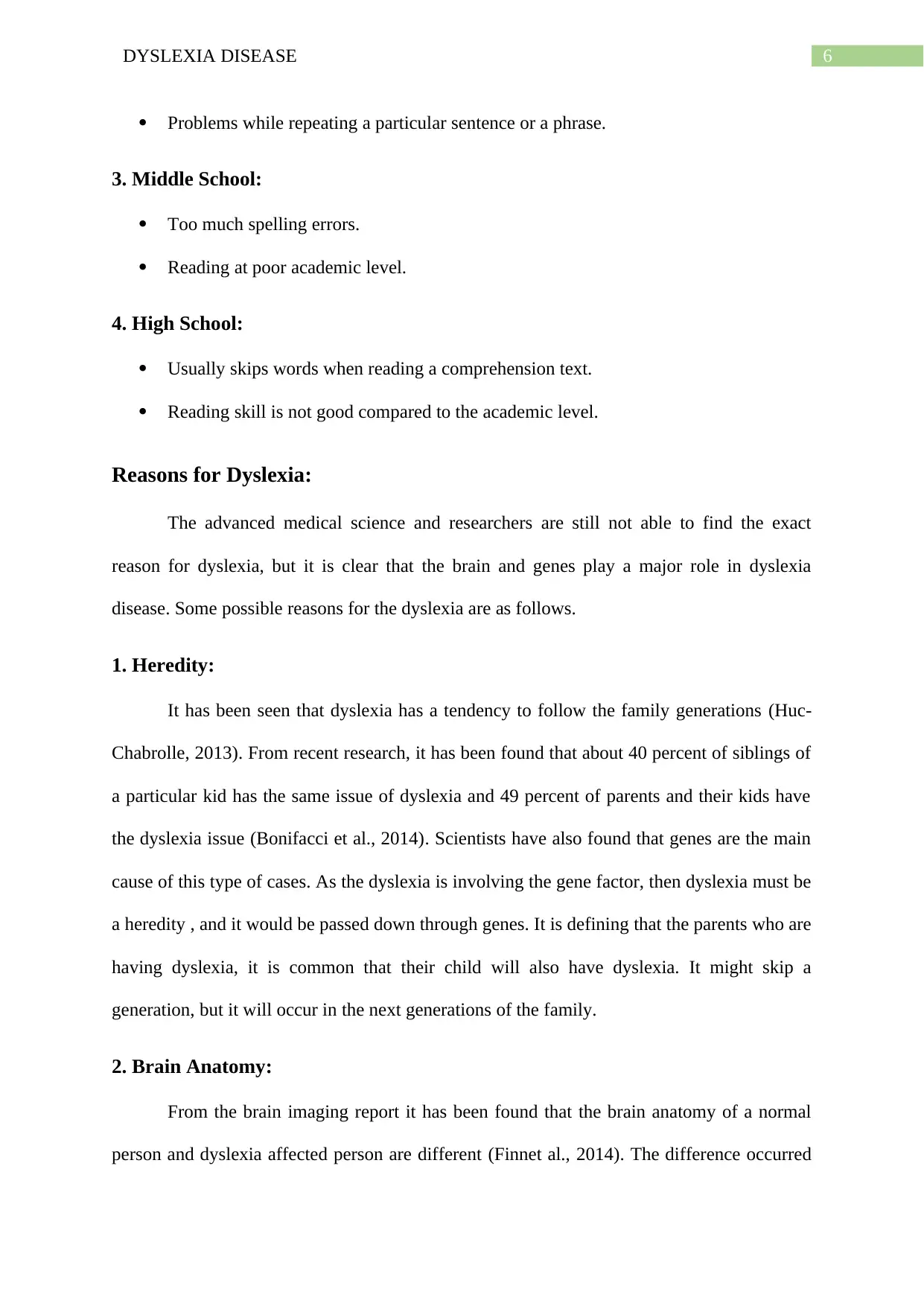
6DYSLEXIA DISEASE
Problems while repeating a particular sentence or a phrase.
3. Middle School:
Too much spelling errors.
Reading at poor academic level.
4. High School:
Usually skips words when reading a comprehension text.
Reading skill is not good compared to the academic level.
Reasons for Dyslexia:
The advanced medical science and researchers are still not able to find the exact
reason for dyslexia, but it is clear that the brain and genes play a major role in dyslexia
disease. Some possible reasons for the dyslexia are as follows.
1. Heredity:
It has been seen that dyslexia has a tendency to follow the family generations (Huc-
Chabrolle, 2013). From recent research, it has been found that about 40 percent of siblings of
a particular kid has the same issue of dyslexia and 49 percent of parents and their kids have
the dyslexia issue (Bonifacci et al., 2014). Scientists have also found that genes are the main
cause of this type of cases. As the dyslexia is involving the gene factor, then dyslexia must be
a heredity , and it would be passed down through genes. It is defining that the parents who are
having dyslexia, it is common that their child will also have dyslexia. It might skip a
generation, but it will occur in the next generations of the family.
2. Brain Anatomy:
From the brain imaging report it has been found that the brain anatomy of a normal
person and dyslexia affected person are different (Finnet al., 2014). The difference occurred
Problems while repeating a particular sentence or a phrase.
3. Middle School:
Too much spelling errors.
Reading at poor academic level.
4. High School:
Usually skips words when reading a comprehension text.
Reading skill is not good compared to the academic level.
Reasons for Dyslexia:
The advanced medical science and researchers are still not able to find the exact
reason for dyslexia, but it is clear that the brain and genes play a major role in dyslexia
disease. Some possible reasons for the dyslexia are as follows.
1. Heredity:
It has been seen that dyslexia has a tendency to follow the family generations (Huc-
Chabrolle, 2013). From recent research, it has been found that about 40 percent of siblings of
a particular kid has the same issue of dyslexia and 49 percent of parents and their kids have
the dyslexia issue (Bonifacci et al., 2014). Scientists have also found that genes are the main
cause of this type of cases. As the dyslexia is involving the gene factor, then dyslexia must be
a heredity , and it would be passed down through genes. It is defining that the parents who are
having dyslexia, it is common that their child will also have dyslexia. It might skip a
generation, but it will occur in the next generations of the family.
2. Brain Anatomy:
From the brain imaging report it has been found that the brain anatomy of a normal
person and dyslexia affected person are different (Finnet al., 2014). The difference occurred
Paraphrase This Document
Need a fresh take? Get an instant paraphrase of this document with our AI Paraphraser
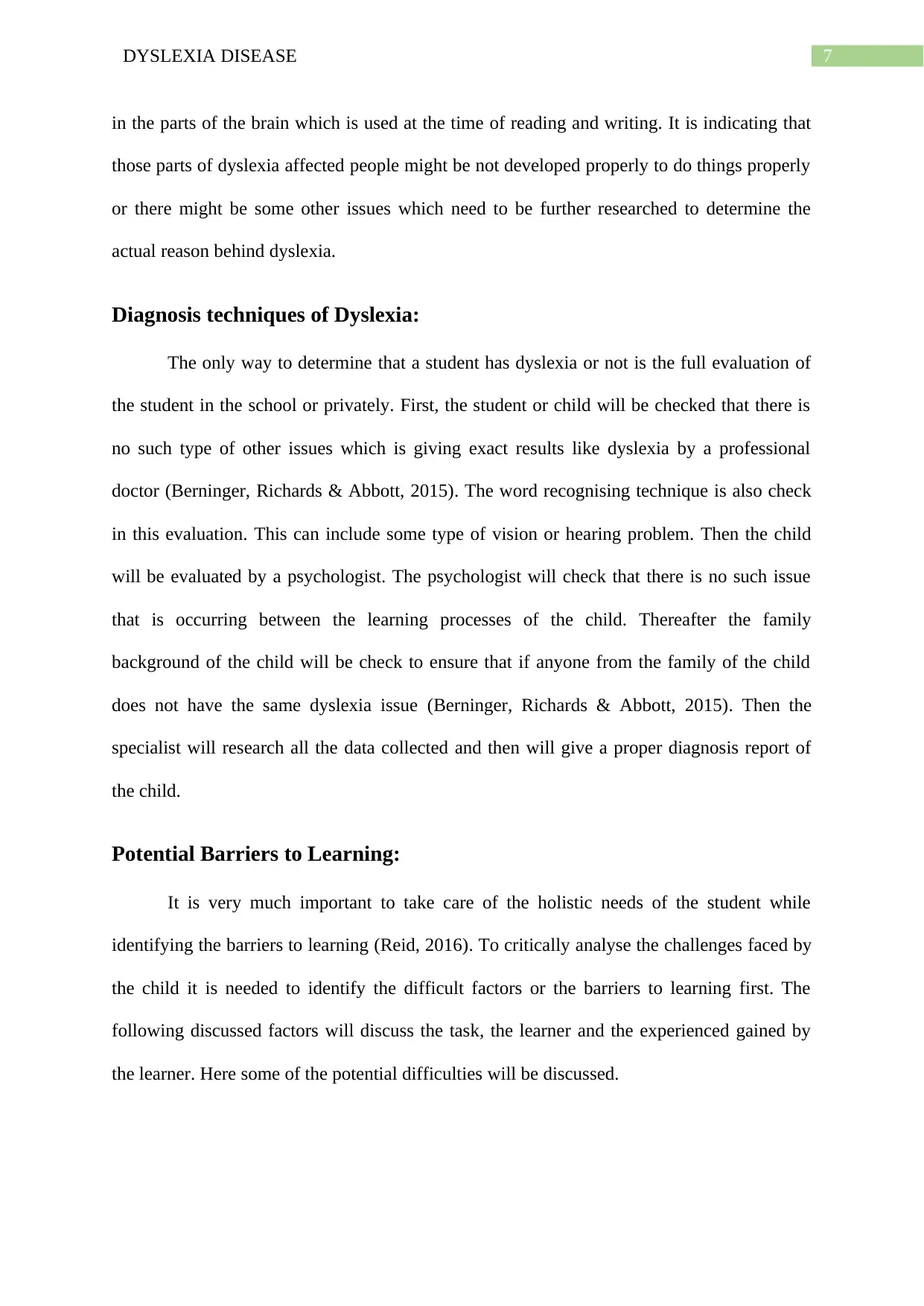
7DYSLEXIA DISEASE
in the parts of the brain which is used at the time of reading and writing. It is indicating that
those parts of dyslexia affected people might be not developed properly to do things properly
or there might be some other issues which need to be further researched to determine the
actual reason behind dyslexia.
Diagnosis techniques of Dyslexia:
The only way to determine that a student has dyslexia or not is the full evaluation of
the student in the school or privately. First, the student or child will be checked that there is
no such type of other issues which is giving exact results like dyslexia by a professional
doctor (Berninger, Richards & Abbott, 2015). The word recognising technique is also check
in this evaluation. This can include some type of vision or hearing problem. Then the child
will be evaluated by a psychologist. The psychologist will check that there is no such issue
that is occurring between the learning processes of the child. Thereafter the family
background of the child will be check to ensure that if anyone from the family of the child
does not have the same dyslexia issue (Berninger, Richards & Abbott, 2015). Then the
specialist will research all the data collected and then will give a proper diagnosis report of
the child.
Potential Barriers to Learning:
It is very much important to take care of the holistic needs of the student while
identifying the barriers to learning (Reid, 2016). To critically analyse the challenges faced by
the child it is needed to identify the difficult factors or the barriers to learning first. The
following discussed factors will discuss the task, the learner and the experienced gained by
the learner. Here some of the potential difficulties will be discussed.
in the parts of the brain which is used at the time of reading and writing. It is indicating that
those parts of dyslexia affected people might be not developed properly to do things properly
or there might be some other issues which need to be further researched to determine the
actual reason behind dyslexia.
Diagnosis techniques of Dyslexia:
The only way to determine that a student has dyslexia or not is the full evaluation of
the student in the school or privately. First, the student or child will be checked that there is
no such type of other issues which is giving exact results like dyslexia by a professional
doctor (Berninger, Richards & Abbott, 2015). The word recognising technique is also check
in this evaluation. This can include some type of vision or hearing problem. Then the child
will be evaluated by a psychologist. The psychologist will check that there is no such issue
that is occurring between the learning processes of the child. Thereafter the family
background of the child will be check to ensure that if anyone from the family of the child
does not have the same dyslexia issue (Berninger, Richards & Abbott, 2015). Then the
specialist will research all the data collected and then will give a proper diagnosis report of
the child.
Potential Barriers to Learning:
It is very much important to take care of the holistic needs of the student while
identifying the barriers to learning (Reid, 2016). To critically analyse the challenges faced by
the child it is needed to identify the difficult factors or the barriers to learning first. The
following discussed factors will discuss the task, the learner and the experienced gained by
the learner. Here some of the potential difficulties will be discussed.
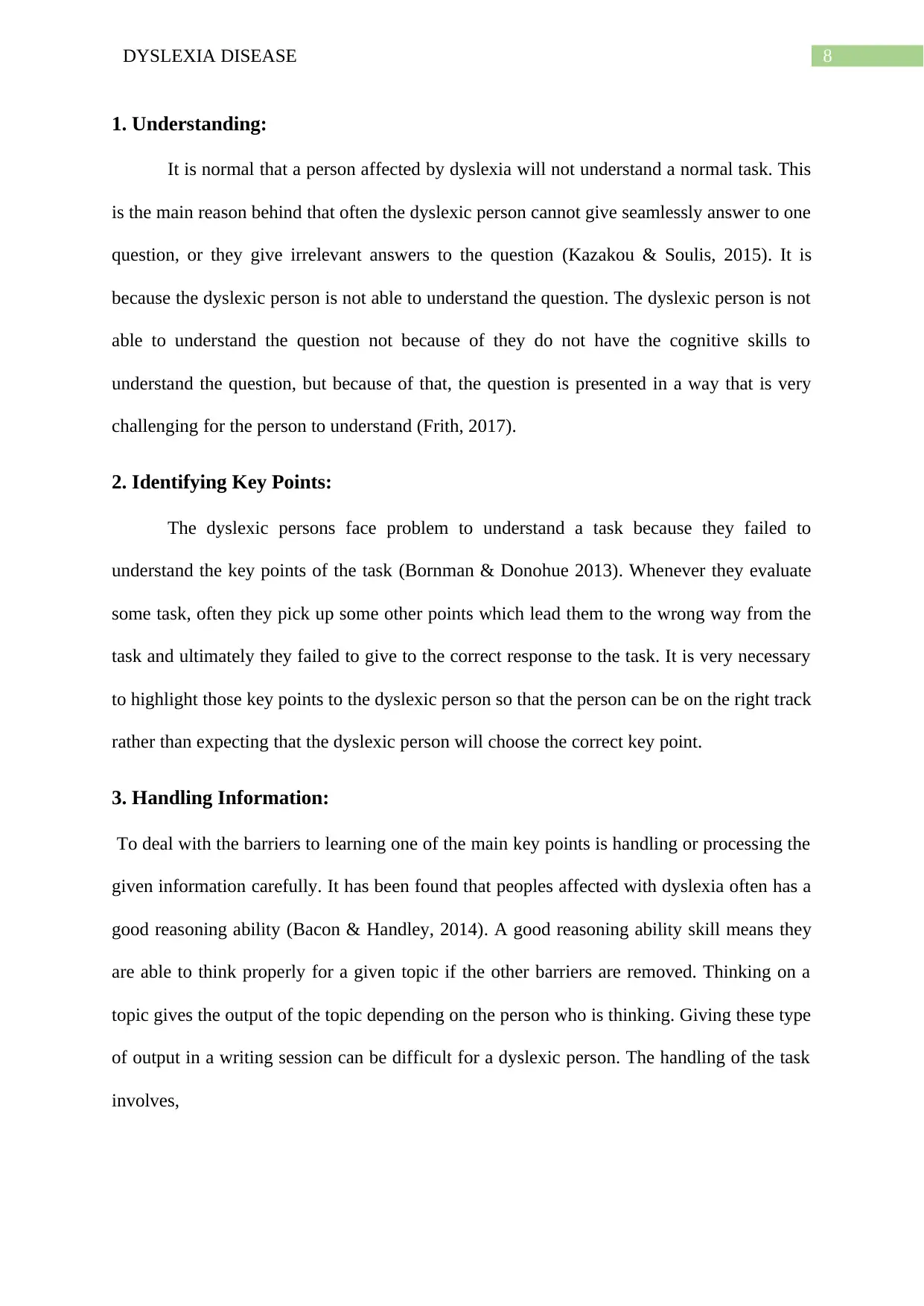
8DYSLEXIA DISEASE
1. Understanding:
It is normal that a person affected by dyslexia will not understand a normal task. This
is the main reason behind that often the dyslexic person cannot give seamlessly answer to one
question, or they give irrelevant answers to the question (Kazakou & Soulis, 2015). It is
because the dyslexic person is not able to understand the question. The dyslexic person is not
able to understand the question not because of they do not have the cognitive skills to
understand the question, but because of that, the question is presented in a way that is very
challenging for the person to understand (Frith, 2017).
2. Identifying Key Points:
The dyslexic persons face problem to understand a task because they failed to
understand the key points of the task (Bornman & Donohue 2013). Whenever they evaluate
some task, often they pick up some other points which lead them to the wrong way from the
task and ultimately they failed to give to the correct response to the task. It is very necessary
to highlight those key points to the dyslexic person so that the person can be on the right track
rather than expecting that the dyslexic person will choose the correct key point.
3. Handling Information:
To deal with the barriers to learning one of the main key points is handling or processing the
given information carefully. It has been found that peoples affected with dyslexia often has a
good reasoning ability (Bacon & Handley, 2014). A good reasoning ability skill means they
are able to think properly for a given topic if the other barriers are removed. Thinking on a
topic gives the output of the topic depending on the person who is thinking. Giving these type
of output in a writing session can be difficult for a dyslexic person. The handling of the task
involves,
1. Understanding:
It is normal that a person affected by dyslexia will not understand a normal task. This
is the main reason behind that often the dyslexic person cannot give seamlessly answer to one
question, or they give irrelevant answers to the question (Kazakou & Soulis, 2015). It is
because the dyslexic person is not able to understand the question. The dyslexic person is not
able to understand the question not because of they do not have the cognitive skills to
understand the question, but because of that, the question is presented in a way that is very
challenging for the person to understand (Frith, 2017).
2. Identifying Key Points:
The dyslexic persons face problem to understand a task because they failed to
understand the key points of the task (Bornman & Donohue 2013). Whenever they evaluate
some task, often they pick up some other points which lead them to the wrong way from the
task and ultimately they failed to give to the correct response to the task. It is very necessary
to highlight those key points to the dyslexic person so that the person can be on the right track
rather than expecting that the dyslexic person will choose the correct key point.
3. Handling Information:
To deal with the barriers to learning one of the main key points is handling or processing the
given information carefully. It has been found that peoples affected with dyslexia often has a
good reasoning ability (Bacon & Handley, 2014). A good reasoning ability skill means they
are able to think properly for a given topic if the other barriers are removed. Thinking on a
topic gives the output of the topic depending on the person who is thinking. Giving these type
of output in a writing session can be difficult for a dyslexic person. The handling of the task
involves,
⊘ This is a preview!⊘
Do you want full access?
Subscribe today to unlock all pages.

Trusted by 1+ million students worldwide
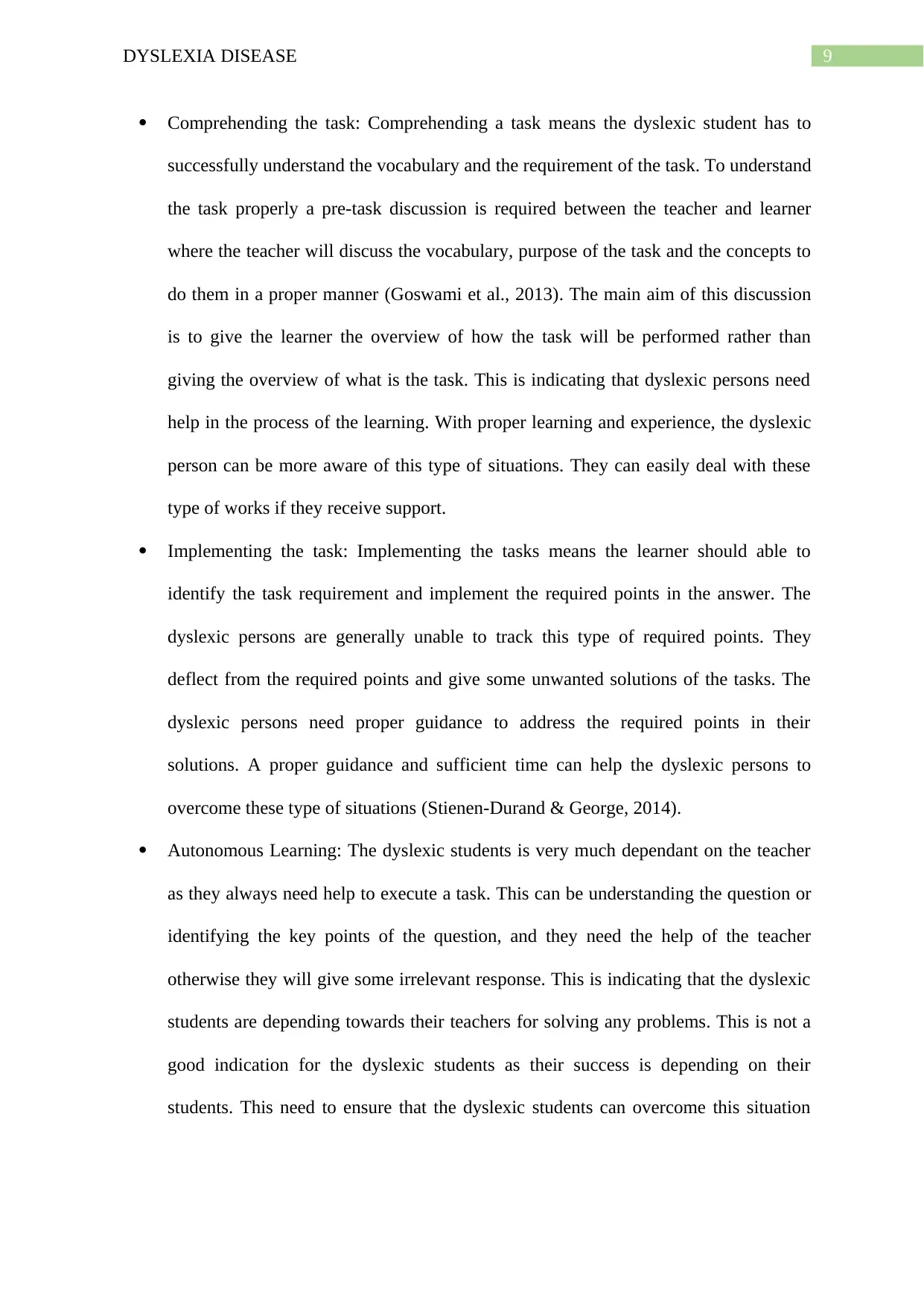
9DYSLEXIA DISEASE
Comprehending the task: Comprehending a task means the dyslexic student has to
successfully understand the vocabulary and the requirement of the task. To understand
the task properly a pre-task discussion is required between the teacher and learner
where the teacher will discuss the vocabulary, purpose of the task and the concepts to
do them in a proper manner (Goswami et al., 2013). The main aim of this discussion
is to give the learner the overview of how the task will be performed rather than
giving the overview of what is the task. This is indicating that dyslexic persons need
help in the process of the learning. With proper learning and experience, the dyslexic
person can be more aware of this type of situations. They can easily deal with these
type of works if they receive support.
Implementing the task: Implementing the tasks means the learner should able to
identify the task requirement and implement the required points in the answer. The
dyslexic persons are generally unable to track this type of required points. They
deflect from the required points and give some unwanted solutions of the tasks. The
dyslexic persons need proper guidance to address the required points in their
solutions. A proper guidance and sufficient time can help the dyslexic persons to
overcome these type of situations (Stienen-Durand & George, 2014).
Autonomous Learning: The dyslexic students is very much dependant on the teacher
as they always need help to execute a task. This can be understanding the question or
identifying the key points of the question, and they need the help of the teacher
otherwise they will give some irrelevant response. This is indicating that the dyslexic
students are depending towards their teachers for solving any problems. This is not a
good indication for the dyslexic students as their success is depending on their
students. This need to ensure that the dyslexic students can overcome this situation
Comprehending the task: Comprehending a task means the dyslexic student has to
successfully understand the vocabulary and the requirement of the task. To understand
the task properly a pre-task discussion is required between the teacher and learner
where the teacher will discuss the vocabulary, purpose of the task and the concepts to
do them in a proper manner (Goswami et al., 2013). The main aim of this discussion
is to give the learner the overview of how the task will be performed rather than
giving the overview of what is the task. This is indicating that dyslexic persons need
help in the process of the learning. With proper learning and experience, the dyslexic
person can be more aware of this type of situations. They can easily deal with these
type of works if they receive support.
Implementing the task: Implementing the tasks means the learner should able to
identify the task requirement and implement the required points in the answer. The
dyslexic persons are generally unable to track this type of required points. They
deflect from the required points and give some unwanted solutions of the tasks. The
dyslexic persons need proper guidance to address the required points in their
solutions. A proper guidance and sufficient time can help the dyslexic persons to
overcome these type of situations (Stienen-Durand & George, 2014).
Autonomous Learning: The dyslexic students is very much dependant on the teacher
as they always need help to execute a task. This can be understanding the question or
identifying the key points of the question, and they need the help of the teacher
otherwise they will give some irrelevant response. This is indicating that the dyslexic
students are depending towards their teachers for solving any problems. This is not a
good indication for the dyslexic students as their success is depending on their
students. This need to ensure that the dyslexic students can overcome this situation
Paraphrase This Document
Need a fresh take? Get an instant paraphrase of this document with our AI Paraphraser
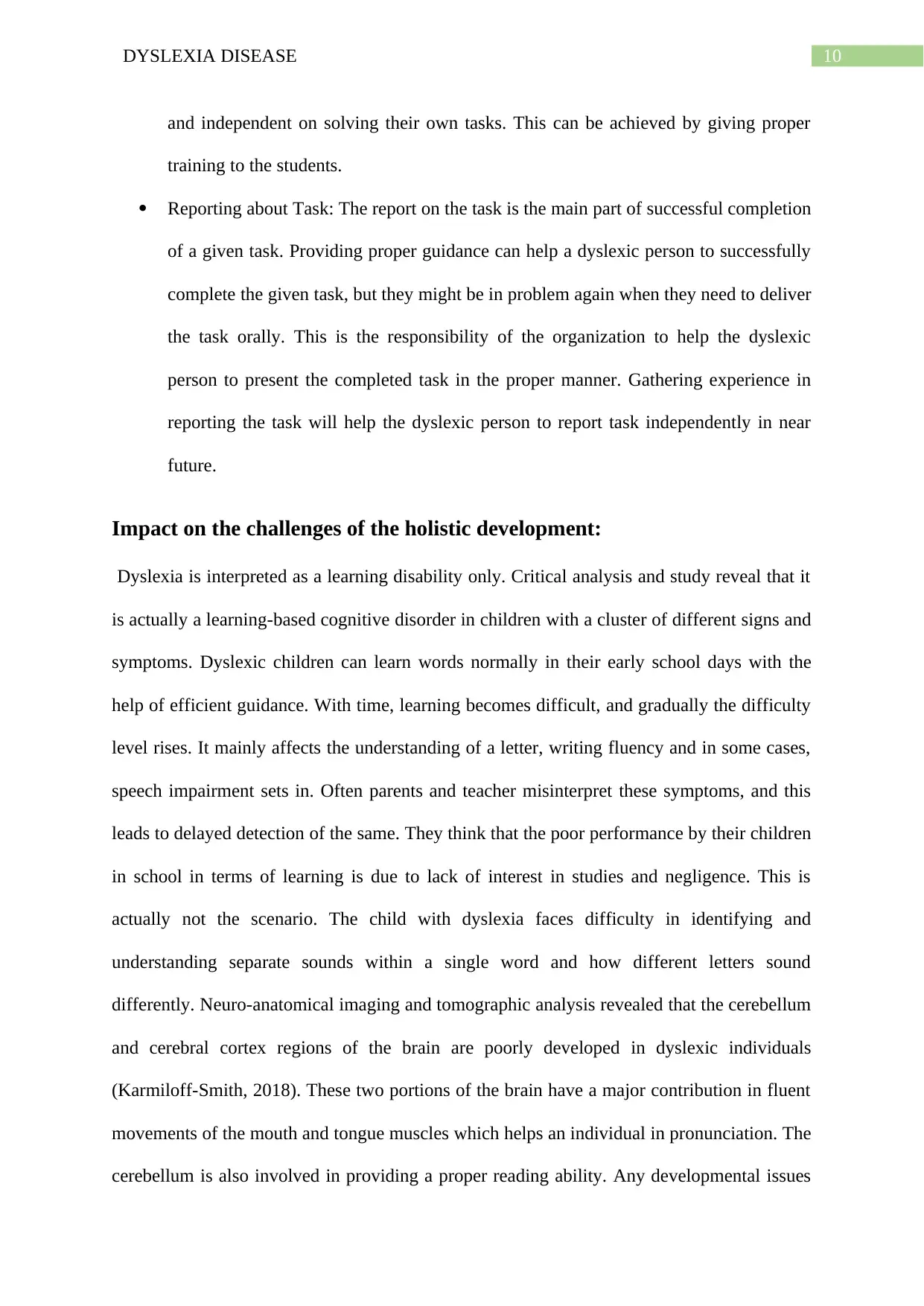
10DYSLEXIA DISEASE
and independent on solving their own tasks. This can be achieved by giving proper
training to the students.
Reporting about Task: The report on the task is the main part of successful completion
of a given task. Providing proper guidance can help a dyslexic person to successfully
complete the given task, but they might be in problem again when they need to deliver
the task orally. This is the responsibility of the organization to help the dyslexic
person to present the completed task in the proper manner. Gathering experience in
reporting the task will help the dyslexic person to report task independently in near
future.
Impact on the challenges of the holistic development:
Dyslexia is interpreted as a learning disability only. Critical analysis and study reveal that it
is actually a learning-based cognitive disorder in children with a cluster of different signs and
symptoms. Dyslexic children can learn words normally in their early school days with the
help of efficient guidance. With time, learning becomes difficult, and gradually the difficulty
level rises. It mainly affects the understanding of a letter, writing fluency and in some cases,
speech impairment sets in. Often parents and teacher misinterpret these symptoms, and this
leads to delayed detection of the same. They think that the poor performance by their children
in school in terms of learning is due to lack of interest in studies and negligence. This is
actually not the scenario. The child with dyslexia faces difficulty in identifying and
understanding separate sounds within a single word and how different letters sound
differently. Neuro-anatomical imaging and tomographic analysis revealed that the cerebellum
and cerebral cortex regions of the brain are poorly developed in dyslexic individuals
(Karmiloff-Smith, 2018). These two portions of the brain have a major contribution in fluent
movements of the mouth and tongue muscles which helps an individual in pronunciation. The
cerebellum is also involved in providing a proper reading ability. Any developmental issues
and independent on solving their own tasks. This can be achieved by giving proper
training to the students.
Reporting about Task: The report on the task is the main part of successful completion
of a given task. Providing proper guidance can help a dyslexic person to successfully
complete the given task, but they might be in problem again when they need to deliver
the task orally. This is the responsibility of the organization to help the dyslexic
person to present the completed task in the proper manner. Gathering experience in
reporting the task will help the dyslexic person to report task independently in near
future.
Impact on the challenges of the holistic development:
Dyslexia is interpreted as a learning disability only. Critical analysis and study reveal that it
is actually a learning-based cognitive disorder in children with a cluster of different signs and
symptoms. Dyslexic children can learn words normally in their early school days with the
help of efficient guidance. With time, learning becomes difficult, and gradually the difficulty
level rises. It mainly affects the understanding of a letter, writing fluency and in some cases,
speech impairment sets in. Often parents and teacher misinterpret these symptoms, and this
leads to delayed detection of the same. They think that the poor performance by their children
in school in terms of learning is due to lack of interest in studies and negligence. This is
actually not the scenario. The child with dyslexia faces difficulty in identifying and
understanding separate sounds within a single word and how different letters sound
differently. Neuro-anatomical imaging and tomographic analysis revealed that the cerebellum
and cerebral cortex regions of the brain are poorly developed in dyslexic individuals
(Karmiloff-Smith, 2018). These two portions of the brain have a major contribution in fluent
movements of the mouth and tongue muscles which helps an individual in pronunciation. The
cerebellum is also involved in providing a proper reading ability. Any developmental issues
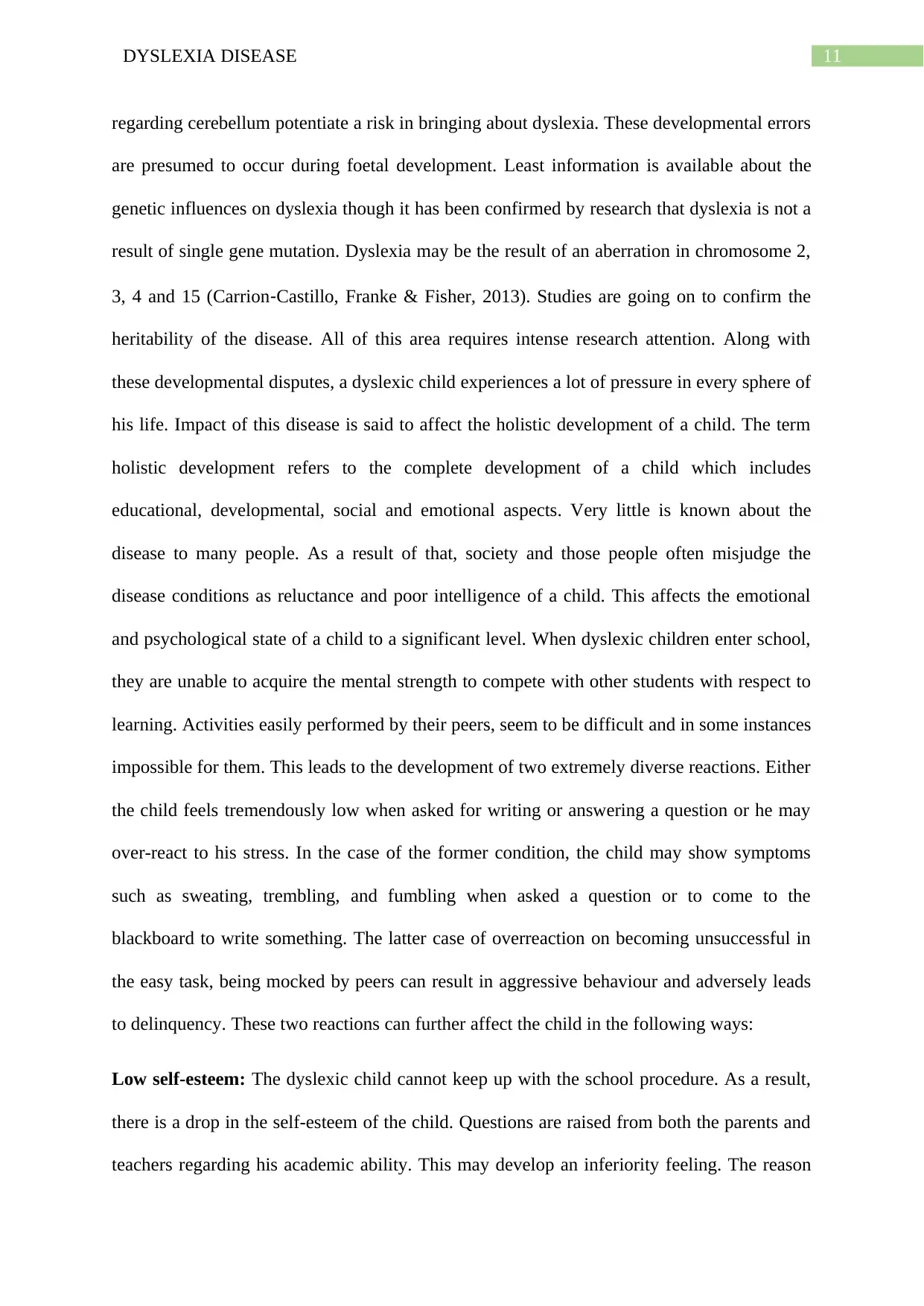
11DYSLEXIA DISEASE
regarding cerebellum potentiate a risk in bringing about dyslexia. These developmental errors
are presumed to occur during foetal development. Least information is available about the
genetic influences on dyslexia though it has been confirmed by research that dyslexia is not a
result of single gene mutation. Dyslexia may be the result of an aberration in chromosome 2,
3, 4 and 15 (Carrion‐Castillo, Franke & Fisher, 2013). Studies are going on to confirm the
heritability of the disease. All of this area requires intense research attention. Along with
these developmental disputes, a dyslexic child experiences a lot of pressure in every sphere of
his life. Impact of this disease is said to affect the holistic development of a child. The term
holistic development refers to the complete development of a child which includes
educational, developmental, social and emotional aspects. Very little is known about the
disease to many people. As a result of that, society and those people often misjudge the
disease conditions as reluctance and poor intelligence of a child. This affects the emotional
and psychological state of a child to a significant level. When dyslexic children enter school,
they are unable to acquire the mental strength to compete with other students with respect to
learning. Activities easily performed by their peers, seem to be difficult and in some instances
impossible for them. This leads to the development of two extremely diverse reactions. Either
the child feels tremendously low when asked for writing or answering a question or he may
over-react to his stress. In the case of the former condition, the child may show symptoms
such as sweating, trembling, and fumbling when asked a question or to come to the
blackboard to write something. The latter case of overreaction on becoming unsuccessful in
the easy task, being mocked by peers can result in aggressive behaviour and adversely leads
to delinquency. These two reactions can further affect the child in the following ways:
Low self-esteem: The dyslexic child cannot keep up with the school procedure. As a result,
there is a drop in the self-esteem of the child. Questions are raised from both the parents and
teachers regarding his academic ability. This may develop an inferiority feeling. The reason
regarding cerebellum potentiate a risk in bringing about dyslexia. These developmental errors
are presumed to occur during foetal development. Least information is available about the
genetic influences on dyslexia though it has been confirmed by research that dyslexia is not a
result of single gene mutation. Dyslexia may be the result of an aberration in chromosome 2,
3, 4 and 15 (Carrion‐Castillo, Franke & Fisher, 2013). Studies are going on to confirm the
heritability of the disease. All of this area requires intense research attention. Along with
these developmental disputes, a dyslexic child experiences a lot of pressure in every sphere of
his life. Impact of this disease is said to affect the holistic development of a child. The term
holistic development refers to the complete development of a child which includes
educational, developmental, social and emotional aspects. Very little is known about the
disease to many people. As a result of that, society and those people often misjudge the
disease conditions as reluctance and poor intelligence of a child. This affects the emotional
and psychological state of a child to a significant level. When dyslexic children enter school,
they are unable to acquire the mental strength to compete with other students with respect to
learning. Activities easily performed by their peers, seem to be difficult and in some instances
impossible for them. This leads to the development of two extremely diverse reactions. Either
the child feels tremendously low when asked for writing or answering a question or he may
over-react to his stress. In the case of the former condition, the child may show symptoms
such as sweating, trembling, and fumbling when asked a question or to come to the
blackboard to write something. The latter case of overreaction on becoming unsuccessful in
the easy task, being mocked by peers can result in aggressive behaviour and adversely leads
to delinquency. These two reactions can further affect the child in the following ways:
Low self-esteem: The dyslexic child cannot keep up with the school procedure. As a result,
there is a drop in the self-esteem of the child. Questions are raised from both the parents and
teachers regarding his academic ability. This may develop an inferiority feeling. The reason
⊘ This is a preview!⊘
Do you want full access?
Subscribe today to unlock all pages.

Trusted by 1+ million students worldwide
1 out of 25
Related Documents
Your All-in-One AI-Powered Toolkit for Academic Success.
+13062052269
info@desklib.com
Available 24*7 on WhatsApp / Email
![[object Object]](/_next/static/media/star-bottom.7253800d.svg)
Unlock your academic potential
Copyright © 2020–2025 A2Z Services. All Rights Reserved. Developed and managed by ZUCOL.





